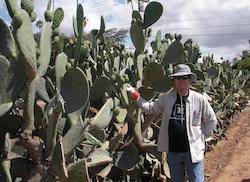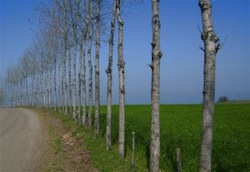A new study has shown that putting the water-use-efficient and turbo-charged photosynthesis from plants such as agave into woody biomass plants can hedge against high temperatures and low moisture. It can also enable growers to plant dedicated energy crops on marginal land.
 A team of researchers including John Cushman, a biochemistry professor at the University of Nevada, Reno; Xiaohan Yang at the Oak Ridge National Laboratory (ORNL); James Hartwell at the University of Liverpool, UK; and Anne Borland at Newcastle University, UK and ORNL are exploring the genetic mechanisms of crassulacean acid metabolism (CAM) and drought tolerance in desert-adapted plants as a way to improve drought resistance for biofuel crops.
A team of researchers including John Cushman, a biochemistry professor at the University of Nevada, Reno; Xiaohan Yang at the Oak Ridge National Laboratory (ORNL); James Hartwell at the University of Liverpool, UK; and Anne Borland at Newcastle University, UK and ORNL are exploring the genetic mechanisms of crassulacean acid metabolism (CAM) and drought tolerance in desert-adapted plants as a way to improve drought resistance for biofuel crops.
The study is part of a five-year, multi-institutional $14.3 million U.D. Department of Energy (DOE) grant, “Engineering CAM Photosynthetic Machinery into Bioenergy Crops for Biofuels Production in Marginal Environments.” The funds are through the DOE’s Office of Biological and Environmental Research, Genomic Science: Biosystems Design to Enable Next-Generation Biofuels.
The team will develop novel technologies to redesign bioenergy crops to grow on economically marginal agricultural lands and produce yields of biomass that can readily be converted to biofuels. The development of water-use efficient, fast-growing trees such as poplar for such sites will also help reduce competition with food crops for usable farmland according to the research team.
“With climate change predictions for a 7 degree Fahrenheit (3.8 degree C) increase in temperature and a decrease in reliable precipitation patterns by 2080 for much of America’s breadbasket, and with a greater need for sources of biofuels for transportation, these biodesign approaches to enhancing biomass production become very important,” Cushman, director of the project, said.
The ultimate goal of the project is to significantly improve an energy crop’s drought resistance by enabling the crop to adapt to hotter, drier climates. The metabolic mechanisms in species that normally perform photosynthesis during the day (known as C3 photosynthesis) will be altered so the plants can take up carbon dioxide at night, when the potential for water loss is lower. This specialized mechanism  of nocturnal photosynthesis is known as CAM.
of nocturnal photosynthesis is known as CAM.
The pores on plant leaf surfaces open and close at certain times of the day to allow water and carbon dioxide to be exchanged. With CAM, the exchange happens mostly at night, when it is cooler and more humid, and then C3 photosynthesis occurs during the day in a more water-wise manner. CAM species can grow and thrive with about 8 to 16 inches of precipitation a year, far less than the 20 to 40 inches per year required for current biofuel feedstocks.
“In order to identify the optimal ‘parts-list’ for introducing CAM-like properties into other plants, we will undertake groundbreaking research on a diverse range of plants that use CAM, with the goal of identifying the key genes and proteins required to make this photosynthetic adaptation work efficiently,” said James Hartwell, University of Liverpool. The first potential biofuel feedstock studied will be poplar trees.
Should the team achieve success, they hope to use the technology in food crops enabling food to be grown in drier and warmer temperatures. This will address growing concerns about how to feed a growing population in a world where water is predicted to become more scarce.

